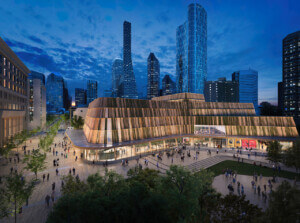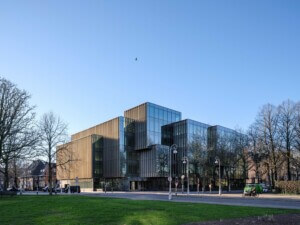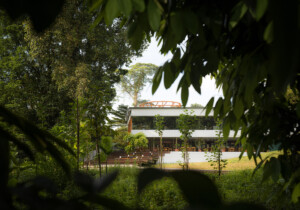Scaffolding on OMA‘s Performing Arts Center in Taipei has begun to come down, unveiling the building’s bulbous facade. Made from aluminum, the facade encases the Proscenium Playhouse and Multiform Theater.
An auditorium, the spherical Proscenium Playhouse caters for an audience of 800. Regarding its relationship to the main building, OMA said it “resembles a suspended planet docking with the cube.” Audiences will circulate between an “inner and outer shell” to enter the space, meanwhile inside, “the intersection of the inner shell and the cube forms a unique proscenium that creates any frame imaginable.”
Also seating 800—and located within the sphere—is the Multiform Theater. A “flexible” space, the theater will play host to a range of experimental performances. It sits opposite the building’s focal point: The Grand Theater. According to OMA, it will be “contemporary evolution of the large theater spaces of the 20th century.” The Grand theater can be merged with its opposite partner to form the “Super Theater.” Here, the “experimental, factory-like environment” will be able to accommodate productions that demand exceptionally large stage settings such as B.A. Zimmermann’s opera Die Soldaten (1958), which requires a 100-meter-long stage. The Super Theater will also offer the chance for existing productions to be scaled up.
According to the firm, the project aims to address the following questions: “Why have the most exciting theatrical events of the past 100 years taken place outside the spaces formally designed for them? Can architecture transcend its own dirty secret, the inevitability of imposing limits on what is possible?”
Discussing their approach further, OMA added:
In recent years, the world has seen a proliferation of performance centers that, according to a mysterious consensus, consist of more or less an identical combination: a 2,000-seat auditorium, a 1,500-seat theatre, and a black box. Overtly iconic external forms disguise conservative internal workings based on 19th century practice (and symbolism: balconies as evidence of social stratification). Although the essential elements of theatre- stage, proscenium, and auditorium- are more than 3,000 years old, there is no excuse for contemporary stagnation. TPAC takes the opposite approach: experimentation in the internal workings of the theatre, producing (without being conceived as such) the external presence of an icon.
Construction on the project has so far taken four years and the Performing Arts Center is due to officially open in 2017. OMA won the commission to design the center in 2009. Rem Koolhaas and David Gianotten are the two partners working on the project.










